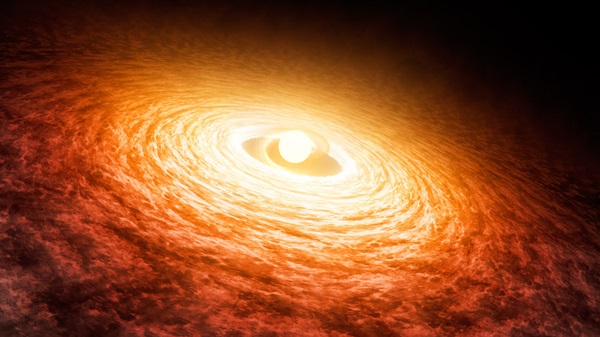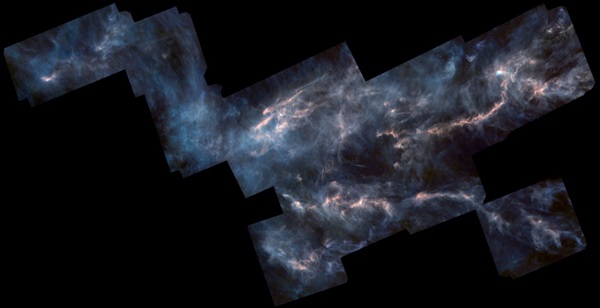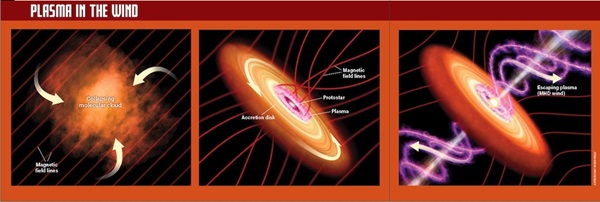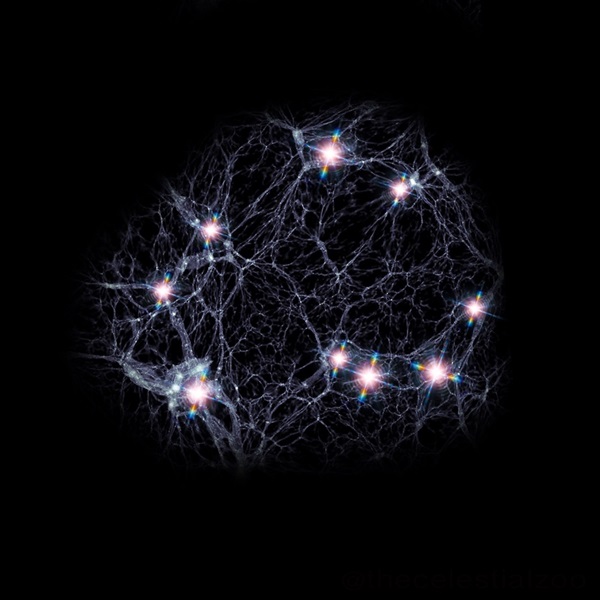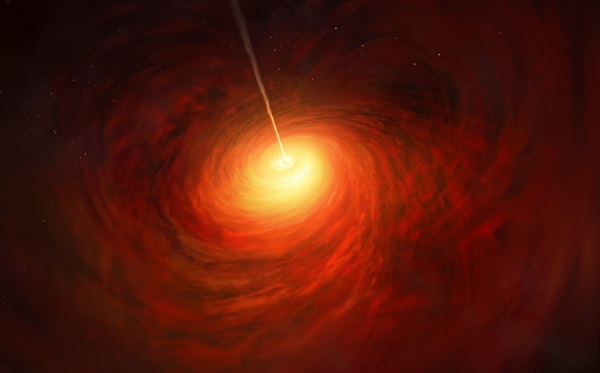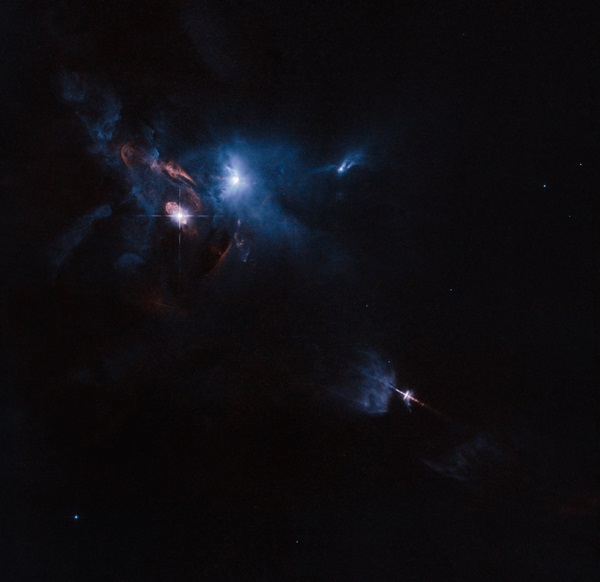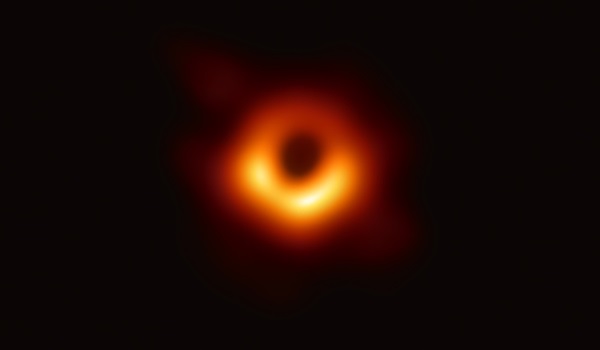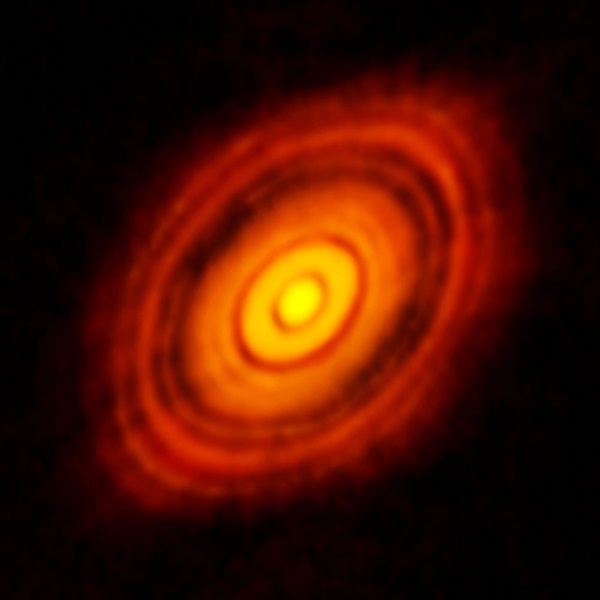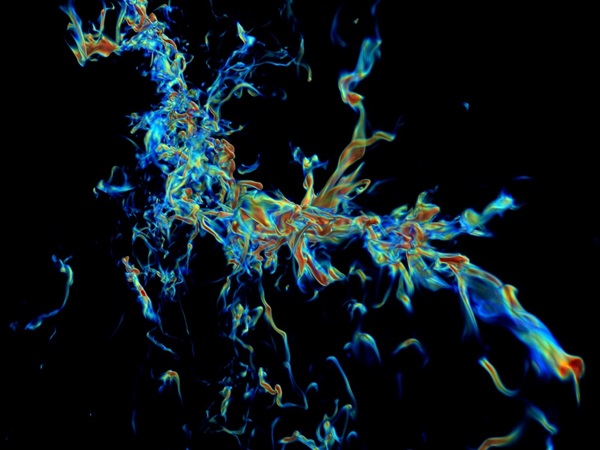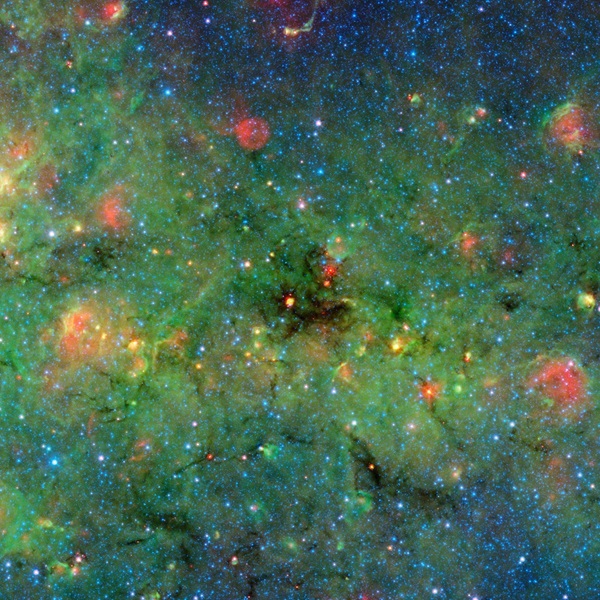Key Takeaways:
- Gravity causes matter to clump together, forming everything from stars to planets.
- Accretion disks form when material swirls around a central object due to conserved angular momentum.
- Magnetic fields may help regulate the collapse of clouds into stars.
- Planets form within accretion disks through processes like streaming instability.
Accretion is one of the most fundamental processes in the cosmos. It is a universal phenomenon triggered by gravity, and the process by which bits of matter accumulate and coalesce with more bits of matter. It works inexorably on all scales to attract and affix smaller things to bigger things, from the tiniest dust grains to supermassive black holes.
Accretion creates everything there is: galaxies, stars, planets, and eventually, us. It is the reason the universe is filled with a whole bunch of somethings instead of a whole lot of nothing.
The fact that matter tends to glom together may seem intuitive. But to scientists, accretion remains a mysterious topic, filled with unanswered questions.
For instance: Why do some stellar nurseries form a few massive stars instead of lots of smaller ones? What causes so much accreting material to ultimately fall inward onto its central object, instead of just circling it forever? And how do space rocks ultimately stick together to form planets instead of just bouncing off each other? No one knows the definitive answers to any of these questions yet, but there are some theories gaining traction — and evidence.
All objects great and small
Accretion is the inevitable result of gravitational forces operating on all scales, and on all types of material — gas, dust, plasma, even dark matter. Gravity makes matter accrete. And when matter accretes, it forms objects. Thus, accretion and formation are very closely related in astronomy: The former can be considered an aspect of the latter.
The Soviet scientist Otto Schmidt devised the first accretion model of planetary formation in 1944, and his countryman Viktor Safronov fleshed out the mathematics of accretion in 1969. The underlying principles of gravitational attraction have since been applied to the formation of stars and even galaxies. The discovery of quasars and compact X-ray sources in the 1960s, using optical, radio, and X-ray observations, set the field in motion.
But the true renaissance began a decade ago, when the Atacama Large Millimeter/submillimeter Array (ALMA), an array of 66 radio telescopes in Chile, came online. With the ability to study distant, cool objects in detail came the data necessary to understand the process of accretion in a variety of circumstances. Seeing accretion in action promised to be a game-changer.
Today, ALMA and other advanced telescopes are observing numerous objects of different sizes and stages of evolution: galaxy groups, molecular clouds, stellar nurseries, protostars, planetary disks, black holes, and many more. We now know that whether on scales of kilometers or light-years, accretion operates on the same broad principles. The particular mechanisms remain mysterious, but the veil is beginning to lift.
The reason that the gas in a molecular cloud can accrete into a star may be due to magnetohydrodynamics (MHD), the physics of how magnetic fields interact with hot ionized gas.
Interstellar space and everything in it is permeated by a weak magnetic field. Normally, this background magnetic field has no effect on a cold, dense cloud of gas and dust.
But this changes when a collapsing cloud heats up and begins to generate plasma. Because plasma is electrically charged, it is linked to the magnetic field: As it moves, it drags the magnetic field lines with it. As the cloud collapses further and begins to form an accretion disk, the magnetic field becomes wound up by the disk’s rotation. The magnetic field also becomes stronger as the field lines bunch together.
All of these magnetic field lines then act as highways for plasma to escape the strong magnetic field: Following the field lines, the charged particles zip away from the accretion disk into space. This MHD wind carries angular momentum away from the disk — and this, astronomers suspect, helps the cloud collapse into a star.
Stellar nurseries at the crossroads
The largest structures in the universe are groups of galaxies that are gravitationally bound to each other. We are not yet able to see them, but peculiar arrangements of objects have been interpreted as evidence of such superstructures. They are given various names according to their observed shapes, such as arcs, rings, or walls.
The observable portions of superstructures consist mostly of molecular clouds of gas millions of light-years across. Over the eons, these diffuse regions are perturbed by a variety of effects: the chaotic motions of the galaxies within them, the winds thrown by quasar jets, the passing wakes of rotating black holes, and blasts from supernovae. Here and there, a confluence of gas and dust will become dense enough that gravity takes over and a domino effect begins, as more and more mass is drawn into a conglomeration, where a star-forming region is born.
The mechanics of these stellar nurseries, from which hundreds or thousands of stars are created, are not completely understood. Sometimes a region containing a few hundred solar masses of dense gas and dust will form 100 Sun-like stars. Other times a few massive stars will also appear. This difference is of particular interest to astronomers because massive stars can alter the evolution of a galaxy. What guides the seemingly random accretion process on these vast scales?
One theory posits that there are “filaments of flowing gas, which thread through these clusters,” says Todd Hunter, an astronomer at the National Radio Astronomy Observatory. Astronomers are starting to see evidence of these filaments. “They fragment and intersect at certain places, especially in the center of clusters,” says Hunter. “And where they meet is where protostars have access to a lot of gas on a short timescale” — which feeds the formation of massive stars.
These objects are called infrared dark clouds, and they are very large, very cold objects that were difficult to detect and resolve until recently. The first observations were made with the Infrared Space Observatory in 1996. It was a serendipitous find, made during the first detailed survey of stellar populations in the galactic plane. Nowadays these regions are studied in detail with ALMA and the Submillimeter Array in Hawaii, which are more sensitive and have higher resolution at submillimeter wavelengths where cold molecular gas is easiest to detect.
These facilities have allowed astronomers to map the gas flows they believe provide the necessary supply for the growth of massive stars. One survey, published in The Astrophysical Journal in 2019, identified hundreds of protostellar and prestellar core candidates in a particular region and studied how they affect each other. The researchers suggest a kind of “competitive accretion” process takes place, alongside what they call “global hierarchical collapse” — where chaotic gravitational forces cause a series of collapses within collapses, with small-scale events happening later and faster than large-scale events. This process works over a couple of million years, eventually transforming a diffuse cloud of starless cores into a flattened disk of protostars.
A widening gyre
Where there is gravity and matter, there will also be accretion. Infalling matter forms a swirling accretion disk. This gravitational gyre forms because the infalling material — like everything else in the universe — had some motion and angular momentum before becoming caught up by an object’s gravity. The laws of physics state that angular momentum must be conserved — so, to fall into a star, black hole, or other object, material must lose its angular momentum first. It cannot be simply sucked toward the core along a straight line. Instead, it forms a flattened structure called an accretion disk.
The closer the material is carried to the center, the faster it spins. (Physicists often use the metaphor of a figure skater to demonstrate this effect; when the skater pulls their arms in, they spin faster.) There’s just a small problem: For material to actually fall onto the core, it must slow down and eventually come to a stop. But how can this happen when the closer it gets, the faster it moves? Why doesn’t it just swirl around forever? What dissipates the angular momentum, allowing gravity to win the tug-of-war?
There are two prevailing theories. “The old idea is that disks are turbulent, and this turbulence generates a kind of viscosity,” or friction within a fluid, says Ilaria Pascucci, an astrophysicist and planetary scientist at the University of Arizona in Tucson. In this scenario, the disk is full of eddies, which means the gas particles don’t orbit smoothly. As inner material accelerates, it drags the material outside of it along for the ride, like a jar of molasses being stirred. “The viscosity redistributes angular momentum outward, enabling disk gas close in to accrete,” says Pascucci.
This turbulence-viscosity model of disk accretion was first suggested around 40 years ago. But astronomers have never really been able to make the numbers add up. The models required disks to be stickier and more viscous than turbulence could probably account for.
Then, in the last decade, an overlooked characteristic of accretion disks — magnetic fields — started to show promise. “What if the angular momentum is not redistributed in the disk, but extracted through winds?” Pascucci says.
Star-forming regions have magnetic fields running through them. While they do not affect neutral gas, particles that have been heated and ionized have an electric charge and will tend to follow these magnetic field lines. As the large-scale clouds collapse under their own gravity, these magnetic field lines also become twisted and tangled. And if magnetic field lines are somehow bent outward, anchored to plasma that remains outside the collapsing cloud, plasma that is zipping along the magnetic field might be able to overcome gravity and accelerate away from the disk. Astronomers call these outflows magnetohydrodynamic (MHD) winds, and they could carry away angular momentum. This would enable the leftover disk material to fall onto the forming protostar.
Both observations and simulations seem to point toward the MHD wind hypothesis. The best evidence so far for an MHD wind is a 2021 study in The Astrophysical Journal of an active young star, where astronomers have measured how high the wind appears to sustain itself as it flows away from the disk. Measuring how powerful these winds are — and therefore how much angular momentum they carry away — will be the next major task in testing the theory.
Disk worlds
At the same time a star is forming, so are the planets that will orbit it. Both star formation and planet formation happen within disks via accretion. As gas and dust swirls around the star, delineations begin to appear in the disk. Astronomers saw this for the first time in 2014 in a young star called HL Tauri. This observation, made using ALMA, was a major advancement in our understanding of how planets form.
In a nascent planetary system, the congregation of matter depends on lots of different factors. Turbulence, magnetic fields, and the play of viscosity between gas and dust may cause a kind of traffic jam that eventually congeals to form protoplanets. Closer in, most of the gas gets consumed by the star, leaving rocky material and heavy metals, which form terrestrial planets.
But there is a long-standing question about how rocky bodies accrete, involving a concept called the bouncing barrier. Electrostatic forces cause small grains to stick together and larger planetesimals are attracted to each other by gravity. But how does a particle become a planet? Models show that objects in that middle range between tiny and massive just tend to bounce off each other. So how do amassing objects overcome this barrier to growth?
One theory is that the particles experience a drag force as they move through gas in the disk. “There’s a strong interaction between solid particles and the gas in the disk,” says James Stone, an astrophysicist at Princeton University. “This causes clumps to form, which over time can produce larger and larger objects.”
So far, this protoplanetary evolution mechanism, called streaming instability, seems to be a promising way to grow things from centimeter to kilometer sizes. The most intriguing part of the theory is that the gas is the crucial component: Without it, dust in the disk couldn’t coalesce to form planetesimals. But there is not yet direct evidence.
The hope is that within a decade or two, we will have seen lots of planets at different stages of formation. This will stand in as a kind of time-lapse and we can judge how well predictions of prevailing hypotheses, like streaming instability, match up to actual exoplanets. This ambitious venture received a kickstart in 2021 with the discovery of the youngest planet ever observed: 2M0437b. The discovery image, taken by the Subaru Telescope on Mauna Kea in Hawaii, shows a world still glowing hot from energy released during its formation, meaning it just recently (astronomically speaking) finished accreting. The study, led by Eric Gaidos of the University of Hawai’i, also fills in our picture of how quickly planetary systems form, because the star is only about 2.5 million years old.
Gathering dust
Every star grows up on its own schedule. The protostar stage is like a star’s volatile teen years. When its accretion disk stabilizes and material stops falling into the core, it becomes a main sequence star. There may still be a debris disk and the planets around might still be figuring out where they orbit, but accretion has largely stopped. That doesn’t mean there won’t be any more accretion in the star’s future, though. Depending on its mass, when fusion ceases, it will then transition into either a white dwarf, a neutron star, or a black hole, all of which can form accretion disks of their own.
The supply for this new disk can come from a variety of sources. Compact objects, like white dwarfs and black holes, may siphon gas from a companion star. A white dwarf may also pull in material that it puffed off in the earlier red giant phase. And when black holes grow and merge to become the supermassive black holes (SMBHs) at the centers of galaxies, they draw material from the vast roaming stars, clouds, and nebulae within the galaxy itself.
As material from the disk falls into the central object — whether a star, planet, or singularity — it releases energy in the form of radiation. The disk itself also radiates as it swirls around the gravity well and heats up, with different factors like viscosity, friction, and speed making some parts hotter than others. The stronger the draw of the central object, the more powerful the radiation emitted, as gas can be transformed into plasma. The groundbreaking 2019 image of the supermassive black hole at the center of the galaxy M87 is not of the hole itself, but of the black hole’s shadow on the charged plasma swirling around it.
A black hole gains mass from everything it accretes over time. But while we understand how Sun-sized black holes form, we don’t know how SMBHs got as big as they are. For example, the SMBH at the center of the Whirlpool Galaxy (M51) in Canes Venatici has a mass equivalent to 1 million Suns. There is no way for a single small, stellar-mass black hole to accrete enough material to grow this large at the universe’s current age.
“It’s one of the biggest mysteries of black hole research,” says Joanna Piotrowska, a graduate student at Cambridge University. The laws of physics limit how quickly an object can accrete matter, called the Eddington limit. Above that limit, the radiation from the accretion disk is so intense, it blows material away — preventing more accretion from happening. “The mass of [SMBHs] exceeds what is expected from continuous accretion at the Eddington limit over the lifetime of our universe,” says Piotrowska.
One proposed solution is that SMBHs were big to start with. Perhaps in the early universe, even before the first stars, there were molecular clouds with just the right conditions to collapse straight away into singularities. The James Webb Space Telescope might be able to shed some light on this dark topic when it comes online this year. It was designed especially to see the first galaxies and stars, and those primordial formations could help us to understand the initial distribution of potential collapsible matter.
And that’s not all …
It’s tempting to picture accretion as a peaceful, gradual, and constructive process, like erosion in reverse. It can certainly take time to get going. But the methods by which an accretor gains mass can be quite quick and chaotic. Recently, observers have seen what they call accretion bursts around protostars — instances of extreme instability in a disk, where large amounts of material suddenly plunge into the star. Hunter recently observed this on NGC 6334 I, a protostar cluster in the Cat’s Paw Nebula (NGC 6334) in the constellation Scorpius, using the Stratospheric Observatory for Infrared Astronomy (or SOFIA). He theorizes that a high proportion of the total accretion of some stars — up to 50 percent — may actually happen in this way.
Furthermore, accretion is not always a constructive process — accretion in one place might actually preclude the process elsewhere. There is a rare kind of supernova, called Type 1ax, where the accretion disk around a white dwarf explodes. The accretion disks around quasars have powerful magnetic forces which shoot material out in supersonic jets. And there is evidence that winds from the jets of actively feeding SMBHs can actually quench, or turn off, star formation in their host galaxies.
These are exciting times for those who study accretion. Astronomers finally have the capability to compare their mathematical predictions to actual astrophysical objects at key stages of their lives. Whether their theories ultimately measure up to reality, or whether new ones will need to be invented to account for observations, only time — and a lot more data — will tell.

